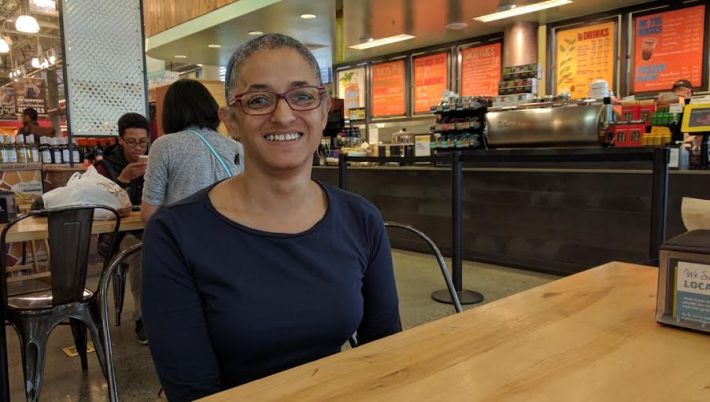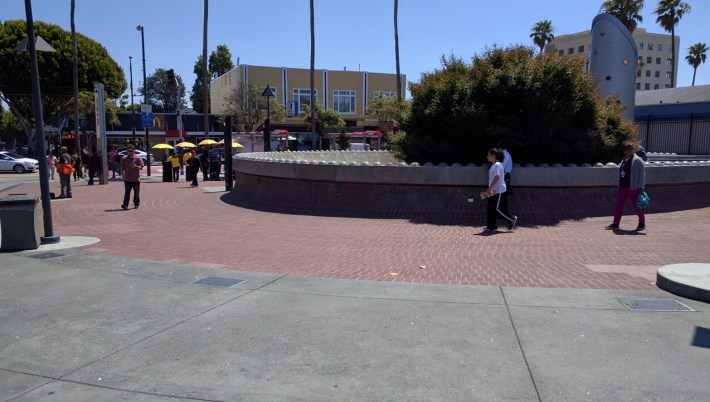
20-year BART board veteran and current board president Tom Radulovich announced yesterday that he will not seek re-election this November. Additionally, he endorsed a replacement: Lisa Feldstein, an instructor at the University of San Francisco. It looks as if Feldstein is going to have quite a bit of competition for Radulovich's seat. That said, Streetsblog figured it worth talking with Feldstein to find out what she's all about and to learn her vision for BART. Streetsblog caught up with her yesterday afternoon at a coffee shop near the Balboa Park BART station.
*
Streetsblog: Let's start with the obvious question. Who are you and why do you want this job?
Lisa Feldstein: I’m a planner and transportation geek and I care a lot about BART. It's the spine of the region and there's a lot we need to do so it serves today's commuters. I grew up in NYC. My grandfather drove a city bus and my dad was from San Francisco. He always talked about San Francisco like it was paradise on earth. So I went to law school in Berkeley, with a plan to return to the East Coast. But I met my spouse. BART has been part of my life ever since, getting to and from jobs, Berkeley law, which I graduated from in 1992, and then I went back to school in 2007 to get a planning degree.
SB: So this is hardly your first foray into politics and planning?
LF: I was appointed to the San Francisco Planning Commission by former Supervisor Tom Ammiano. Then from there I took a job with a non-profit, teaching public health professionals in planning. The idea was public health professionals have to clean up from planning decisions. Planning and public health started as one thing, and they separated. Planners made non-walkable suburbs which helped with communicable disease but led to chronic disease.
SB: Such as diabetes and heart disease from the lack of exercise?
LF: Public health people had figured out what the problem was but had no idea how to intervene so my job was to teach them at the front end so they could work with planning departments.
SB: And now it's generally recognized that bad planning leads to bad public health outcomes.
LF: Right. And the partnership [between health and planning] has been very successful, putting health elements into general plans.
SB: You had a law degree. But you decided to go back and study planning, even though you were already working in it?
LF: My daughter was young at the time. And I burned out on all the travel, but I liked the teaching part. So I went back and got a PhD so I could teach.
SB: You've been doing that for a while. So you want to get back into hands-on work with BART?
LF: I like the idea of being able to stick my hands back in and make some positive change on issues that I’ve been thinking about for so long. Some of that is transportation specific, but a lot of it has to do with equity.
SB: How so?
LF: BART is not that old a system, but it was created for a white middle class, mostly men, and that’s not really the ridership anymore.
SB: Right. If you look at old pictures of BART, the ridership is very, well, monochromatic.
LF: Today's ridership is much more diverse, racially, socially, economically and we don’t have a single commute pattern anymore.
SB: It's not just people commuting from the suburbs to Market Street.
LF: Lots of people, particularly low income, are commuting from suburb to suburb. BART is over capacity and it doesn’t serve the needs of the Bay Area's population today.
SB: Right. So if you're working a night shift, BART kind of sucks.
LF: When I was studying for my qualifying exam in planning, the last Transbay service was like at 12:02. If I missed it, I had to walk miles to get a bus that ran all night. So I'll be advocating for extended service, but I understand there are real issues with maintenance. BART has to have buses, at least, that run all night.
SB: You're talking about a dedicated service?
LF: Yes, to help people work swing shifts, night shifts and weekends.
SB: What are some other things you hope to work on with BART?
LF: The platforms at rush hour; they get backed up onto the stairs. It's a matter of time before someone falls--we need to manage the capacity.
SB: Sounds like you would support peak pricing, like commuter railroads back east.
LF: Part of BART's problem is it’s not quite commuter rail, but it’s not quite a subway either. You can do peak hour pricing, but BART’s already expensive. The pricing structure looks like commuter rail, so you end up creating further inequities for people who don’t have other choices. Lower income people have the least flexibility, but you’re now asking them to pay more. BART doesn’t even have monthly passes, so if you moved to a peak-ride cost, you have to first do something about passes.
The other problem, especially for low income people, is BART is connected to 28 other transit systems. It’s outrageous that when you transfer from BART to Muni you get a discount, but not in the other direction. AC transit used to have the reduced fare for transfers, but they had budget problems. So that was something that just got eliminated.
SB: Travel to Europe, to a city such as London, and you have one card and one fare and you can ride anything. We have Clipper--but there are still so many different agencies with different fares. Why can't we get the fare structure more rational?
LF: The Europeans have the advantage that the government structure is more centralized. The government can say “you’re going to do it this way.” But here--and it’s the same with land use planning--every jurisdiction does whatever it wants.
SB: Which is why we have a suburban-style McDonald's with a drive through on Ocean on a major transportation corridor?
LF: Or the one near me on Haight and Stanyan. But even near a BART station, usually, once you get back to ground level, it's not BART's jurisdiction. But it's not as if BART always does a great job either. Look at the plazas at 16th and 24th and Mission.

SB: Which attract vagrants and riffraff. We need more BART police patrolling those plazas?
LF: I’ve seen SFPD occasionally and I’ve seen BART police. But there’s a lot of tension because of gentrification. There's a sense that you’re just making it safe for the gentrifiers. When 16th street was first redone, it may have been six or seven years ago, it was informed through a community process. The tile and imagery were reflective of the people who lived, there, but putting in tile doesn’t change everything. Short of relocating the homeless, there’s never been an effective way of doing it. But we relocated them during the Super Bowl.
SB: Is relocation the answer? BART plazas and often the trains and stations are a sort of homeless shelter.
LF: It's an expensive problem to solve. BART has a homeless outreach person. And he works with the homeless people in the BART system. But it's a resource issue. Even if a homeless person says to him: “Yes, I’m ready. Get me housing services.” He has to answer with: "I’m sorry but there’s a six-month wait list." We do a lot to get services to people in need but don’t really have resources. It’s a perennial problem.
SB: So how do you get those resources for the homeless?
LF: It’s easy to get money for infra and operations.
SB: For operations? I've never heard that before.
LF: You run the trains on your fares and the government picks up everything else. But what gets lost in that is the more human stuff. How do you deal with the homeless problem. BART can’t open up treatment facilities.
SB: Okay. I see what you mean. So, to get back to planning for a moment, we're down the street from the Balboa Park station, which should be a great transit hub, but is incredibly difficult to access. How would you fix it?
LF: Other than blow it up and start again? Don’t write that.
SB: Why not? You're joking, but I think everyone knows the Balboa station is awful.
LF: The idea behind Balboa Park was very smart: have a transit mode where people can switch between different systems. But the design is Brutalist from an era where that was considered forward thinking.
SB: But there are things to be done.
LF: (Nods) The station is extremely confusing; worse now that everything is under construction.
We need better signage. Signage makes a huge difference. We also need to make people feel comfortable when walking. Some of that is better lighting. When I was walking here, I headed down something that I thought might be a maintenance path, I wasn’t sure if I was supposed to be there.
A lot of what’s there is not terribly weather proof. It needs to be rebuilt to provide shelter from the wind. There’s probably work they can do with building shape and design to reduce wind at that location.
SB: Can you name accomplishments in the past few years that are a step in the right direction for BART?
LF: The system has gotten a lot less clean which really upsets people. Because it’s expensive people expect it to be not quite so filthy. That’s no reflection on the people whose job it is to keep it clean. They can only do so much at the turn around. So it's good that they are removing carpet and using less permeable fabrics. These are steps in the right direction. I think we need to provide more trash cans on platforms.
SB: In your opinion, how's it working to allow bikes on trains during rush hour?
LF: I’ve seen very few problems from my riding of BART. Cyclists understand that this is something they didn’t have for most of BART’s history and it can be taken away, so they are generally thoughtful and considerate. I think it’s working well.
SB: The upcoming BART bond. Pitch it to the voters.
LF: The bond is necessary because the system is buckling under decades of deferred maintenance. It needs repair, upgrades, and rebuilding. The capital needs are large and immediate; without the infrastructure work that is necessary BART’s safety and reliability will be in jeopardy. The bond, which is specific about what work the money will fund, is critical.
SB: Any last thoughts on the possibility of filling Tom Radulovich's shoes?
LF: I’ve known Tom for over two decades and have always had nothing but respect and admiration for his work on land use and transportation and am very conscious of how big his shoes are. I’m glad he’s not leaving town and I can still rely on his council and his encyclopedic knowledge of BART history. I’m honored that he trusts me with this system he’s devoted two decades to.
This interview was edited.





